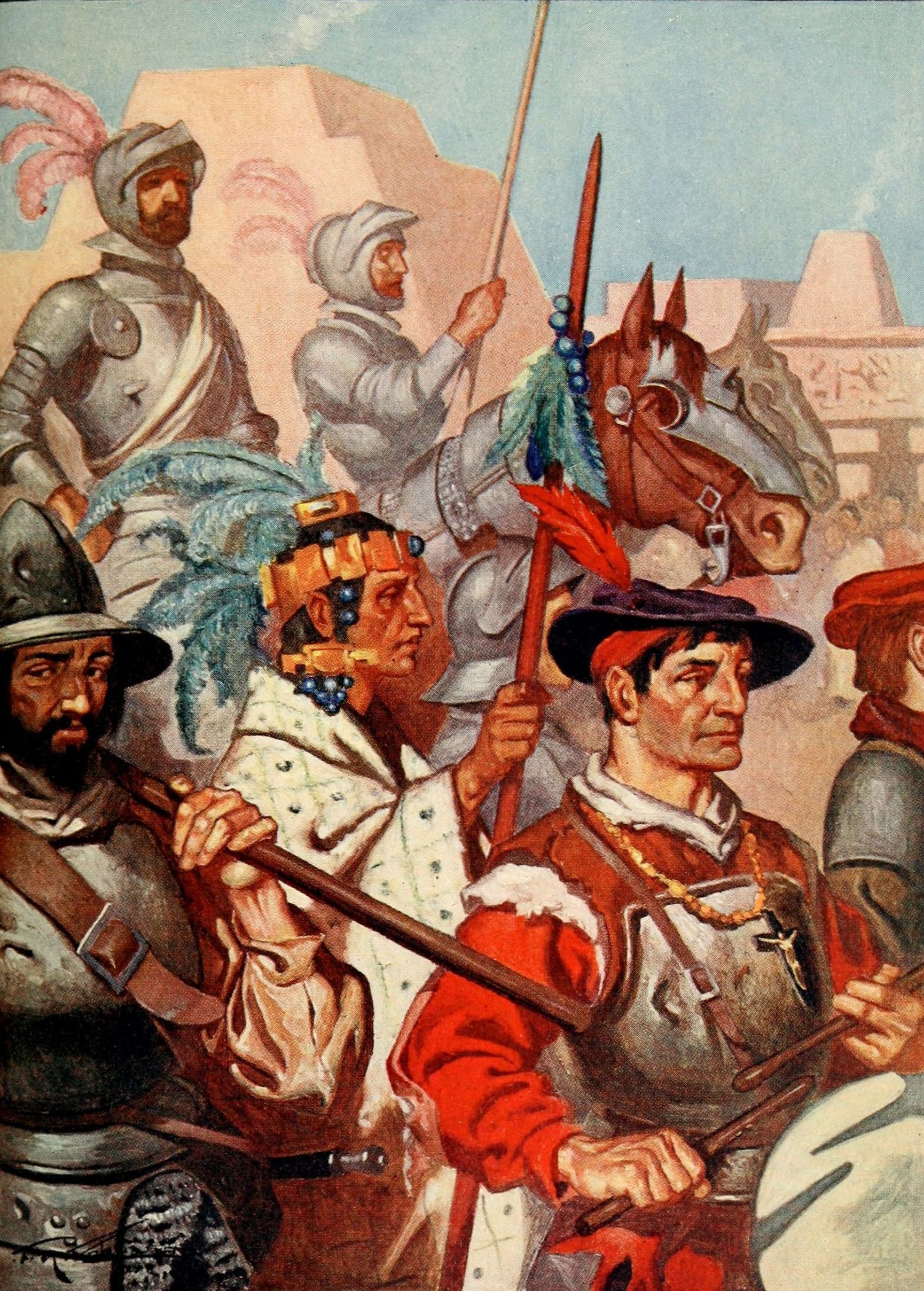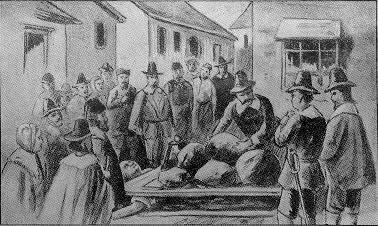Have you ever wondered why America, as a country, is such an aberration amongst first world developed countries in terms of religious belief? Well, the first major reason is that the foundations of modern America were built by religious zealots. And the second major reason is that American, compared to other Western countries, has relatively high levels of income inequality and large parts of the population experience financial and other insecurity: they need religion for hope and comfort.
 |
| The conquistadors entered Tenochtitlan to the sounds of martial music |
The Native Americans and their religious beliefs and practices were highly localised and diverse. When Columbus claimed the Americas for Spain, however, the Spanish set about gaining souls for "Holy Mother Church". The French were eager to follow Spain's example and the first French Jesuit priest arrived in America in 1611, with the aim of converting the Native Americans to Catholicism.
In 1566, Sir Humphrey wrote an essay to convince the English Queen, Elizabeth 1, to begin settlements in the New World. He asked permission "to inhabit and possess at his choice all remote and heathen lands not in the actual possession of any Christian Prince".
The British colonisation of the Americas began in 1607, at Jamestown. The British bringing with them government, language, customs and beliefs that are still prevalent today. Thirteen years later, the Pilgrims who were members of the radical English Separatist Church, fled to America to escape the jurisdiction of the Church of England. They landed at Plymouth in Massachusetts, where they believed that they could build a society of "saints".
Interestingly, while America's Founding Fathers fell into three main religious categories: Deists, practising Christians and those who were essentially Christians but influenced by Deism. They were aware of the bloody history of Europe and the wars that had raged there in the name of religion. They held the view that the best way to protect religious liberty, was to keep the government out of religion. This is why John Adams said, “The government of the United States is not, in any sense, founded on the Christian religion.”
Other religious English colonies were set up. Maryland was established in 1634, after Lord Baltimore was ordered out of Virginia for being a Roman Catholic. The English settlements in Maine, New Hampshire, Connecticut and Rode Island steamed ahead; with Rhode Island being a particular enclave of dissenters of many varieties. In 1681, the Quaker, William Penn was granted a royal charter and he founded Pennsylvania. In 1681, the city of Philadelphia was planned and developed; the name from the Greek φιλεω (phileo) "to love" and αδελφος (adelphos) "brother".
The belief in witches and the presence of Satan as a daily reality was an unfortunate side effect of Puritan society. Matters in New England came to a head in the 1680-90s. A hundred years before this, In 1597, King James VI of Scotland had published a compendium on witchcraft lore called Daemonologie and he had also participated in a number of trials of alleged witches. The Salem witch trials, however, resulted in 200 people being accused of witchcraft and 19 being found guilty and executed by hanging (14 women and five men). The Puritans subscribed to a literal reading of Exodus 22:18, in the Bible, with its instruction that, “Thou shalt not suffer a witch to live.”
Other Europeans came to set up colonies in America, like the Dutch, who started a settlement on Manhattan island in 1623. The Dutch were more interested in business and money than religion and declared that people, "shall keep and enjoy the liberty of their consciences in religion". Although, Quaker missionaries were forbidden for a while. In 1664, New Amsterdam passed to the English and became New York.
And what of Mormonism? According to Wade Clark Roof, professor of religious studies at the University of California, Santa Barbara, the Mormon story is quintessentially American. “It has all the features we associate with being American: patriotism, country, entrepreneurship, capitalism, all bound together.” Mormons are also, mostly white, are generally quite conservative and support the Republican Party. And yet, Mormons, have also largely distanced themselves from the broader community and built separate enclaves, as did the Pilgrims of in New England, who were also separatists.
America, compared to many other Western countries, not only has a very large gap between the rich and the poor, but it also exhibits geographic inequality, with more affluent areas being found in the Northern states and the Southern states having some of the largest concentrations of distressed communities. In terms of religious belief, Mississippi, Alabama and other Southern states are among America's most religious states, while New Hampshire, Massachusetts, Vermont and Maine in New England, among the least religious. However, according to economist Robert Riech, 80% of the American population is living from pay check to pay check. He also says that America doesn’t have a jobs crisis. It has a good jobs crisis.
So America, with its long traditions of religious zealotry has also experienced high levels of industrial decline and now, has a middle class which is turning into the Precariat, or as Alissa Quart discusses in her book, Squeezed “the hypereducated poor”. And this, largely explains why Americans are different from their European cousins.
In 1566, Sir Humphrey wrote an essay to convince the English Queen, Elizabeth 1, to begin settlements in the New World. He asked permission "to inhabit and possess at his choice all remote and heathen lands not in the actual possession of any Christian Prince".
The British colonisation of the Americas began in 1607, at Jamestown. The British bringing with them government, language, customs and beliefs that are still prevalent today. Thirteen years later, the Pilgrims who were members of the radical English Separatist Church, fled to America to escape the jurisdiction of the Church of England. They landed at Plymouth in Massachusetts, where they believed that they could build a society of "saints".
The belief in witches and the presence of Satan as a daily reality was an unfortunate side effect of Puritan society. Matters in New England came to a head in the 1680-90s. A hundred years before this, In 1597, King James VI of Scotland had published a compendium on witchcraft lore called Daemonologie and he had also participated in a number of trials of alleged witches. The Salem witch trials, however, resulted in 200 people being accused of witchcraft and 19 being found guilty and executed by hanging (14 women and five men). The Puritans subscribed to a literal reading of Exodus 22:18, in the Bible, with its instruction that, “Thou shalt not suffer a witch to live.”
 |
| Giles Corey was pressed to death during the Salem witch trials in the 1690s |
 |
| The area roughly considered to constitute the Bible Belt |
Higher levels of religious belief have also been correlated with financial and other insecurity, like worse social environments and personal insecurity. Denmark and Sweden are among the least religious nations in the world; they also possess extensive social safety nets, free education and universal health care. America, on the other hand, has millions of working poor, who find that having a job is not always a path out of poverty and many are left with inconsistent or no health care. So in a sense, religious belief also reflects, to a great extent, the American class system and a person' experience of economic vulnerability.
America, compared to many other Western countries, not only has a very large gap between the rich and the poor, but it also exhibits geographic inequality, with more affluent areas being found in the Northern states and the Southern states having some of the largest concentrations of distressed communities. In terms of religious belief, Mississippi, Alabama and other Southern states are among America's most religious states, while New Hampshire, Massachusetts, Vermont and Maine in New England, among the least religious. However, according to economist Robert Riech, 80% of the American population is living from pay check to pay check. He also says that America doesn’t have a jobs crisis. It has a good jobs crisis.
So America, with its long traditions of religious zealotry has also experienced high levels of industrial decline and now, has a middle class which is turning into the Precariat, or as Alissa Quart discusses in her book, Squeezed “the hypereducated poor”. And this, largely explains why Americans are different from their European cousins.


